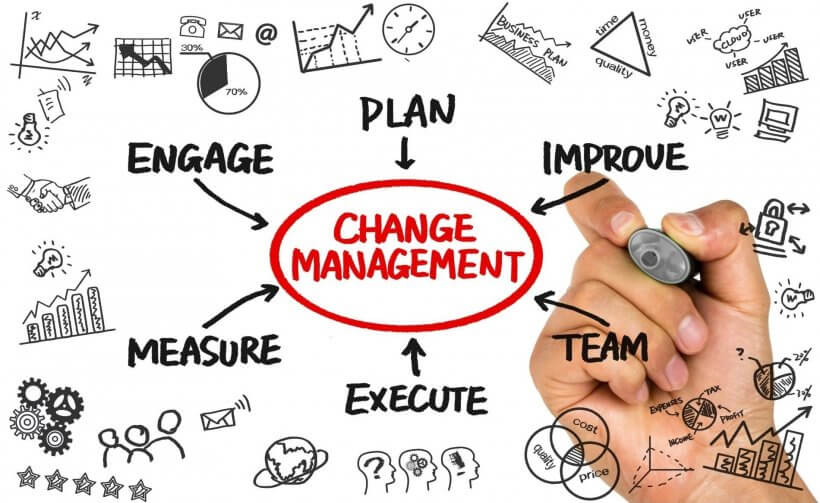Don’t miss the opportunity to Ignite Innovation at THE MAKEOVER 2023, where these strategies and more will be explored to ensure your organization stays competitive and sustainable for the long haul.
Effective approaches to managing change in organizations

Sep 27, 2023
Last updated on Jul 18, 2024
In today's rapidly changing world, organizations of all sizes are facing unprecedented challenges from the fast pace of technological changes, shifting market trends, and increasing globalization. It’s a requirement for businesses to be able to adapt to the new economic environment as well as make changes as necessary to move forward.. However, as innovation and change are a must to every business, effectively managing change in organizations becomes an equally crucial challenge for businesses and leaders to navigate.

Managing organizational change involves a complex process of transforming an organization’s structure, culture, or processes to better align with its goals and objectives. It requires a multifaceted approach that takes into account various factors such as technology, human capital, business culture, policies, customer needs and more.. To address these complexities effectively, proactive planning and employee engagement play a crucial role. Organizations need to plan ahead and anticipate potential challenges that may arise during the change process. This article explores the most effective approaches to managing change in organizations.
Prioritize people and culture
The human element is critical when it comes to managing change in organizations. Employees are the driving force behind any organization, and involving them in the change process is essential. It is crucial to create a change-ready culture that encourages employees to embrace new ideas and adjust to new ways of doing things.
In addition, providing emotional support and wellness programs can help ease the transition for employees. A study of the “happy worker” hypothesis notes that employees who are more satisfied with their jobs are more productive. Therefore, offering wellness programs such as counseling and mindfulness training can be an effective way to manage change in organizations.
Engage leadership and build capability
Leaders play a critical role in managing change in organizations of all sizes. Engaging leadership strategies can help build a positive culture and empower employees to perform their best, leading to better outcomes for the company as a whole. Effective leaders skilled in change and innovation management are critical for success in today’s fast-paced and constantly evolving business landscape.
A crucial role of a leader is to keep things on track and ensure that everyone is working toward the same goals. This means monitoring performance, providing feedback, and addressing any issues or concerns that arise. Leaders must be proactive in identifying potential obstacles and finding ways to overcome them. They should also be open to feedback and willing to adjust their approach as needed to achieve the desired results.
To be effective leaders, individuals must possess certain skills and knowledge. Therefore, training leaders and employees for upcoming changes is essential. This involves providing ongoing education and development opportunities that help them stay current with the latest trends and practices in their field. This could include attending workshops, conferences, and seminars or enrolling in courses that cover topics such as leadership development, team building, communication, and strategic planning. By engaging leaders and building their capabilities, organizations can better prepare for the future and achieve their goals.

Use a structured and data-driven approach
A structured and data-driven approach helps organizations manage change more effectively. By breaking down the change into smaller, more manageable steps, you can better understand how to implement the change and what resources will be required. Additionally, the model can help you identify potential obstacles, such as company culture or employee psychology, that may hinder the change effort.
Additionally, using data and key performance indicators (KPIs) to inform decisions and measure success is critical. By setting specific KPIs, you can establish clear targets for success and track progress towards achieving them. For example, if your implementation involves improving customer satisfaction, you might set a KPI for customer feedback ratings. By tracking this metric over time, you can see whether your efforts are having the desired impact and adjust your approach if necessary.
It is important to set specific KPIs to know what success is when creating a change initiative. However, it is also important to find ways to shape KPIs so that they do not strain creativity. When people are solely focused on hitting specific targets, they may become less willing to take risks or try new things. Creativity requires the freedom to explore ideas and experiment with new approaches.
To avoid this, businesses and organizations must find ways to shape KPIs that encourage creativity. One way to achieve this is by setting goals that are ambitious but flexible. Instead of setting hard targets, consider setting aspirational goals that challenge people to think outside the box. Process-oriented KPIs, like a performance management system, measure progress towards achieving a particular process or methodology, rather than a specific outcome. This approach encourages experimentation and innovation since it focuses on the journey rather than just the destination.
Empower employees through communication
Clear and ongoing communication is vital when managing change in organizations. It helps employees understand why the change is necessary, how it will affect them, and what their role is in the process. This understanding drives employee engagement and helps create ownership and commitment to the change initiative.
Involving employees in the change initiative is a powerful way to identify obstacles and gather feedback. Surveys, focus groups, and two-way communication can help organizations understand employee perceptions of the changes.
Leverage technology or outsourced solutions for support
Digital tools such as project management software and analytics can facilitate communication and tracking during the change initiative. These tools provide a platform for collaboration, sharing information, and monitoring progress. Additionally, technology can help organizations analyze data to measure the impact of the change initiative and make data-driven decisions. Not only so, borrowing assistance like full hr outsourcing is also an effective way to equip business with enough resources and market updates. The HR consulting firm can and will provide in-depth consultation about approaches to improve business innovation.
Furthermore, by outsourcing tasks to experts, businesses can gain access to their knowledge and expertise without having to invest in the time and resources to develop it in-house. Outsourcing, when aligned with the purpose of innovation in business, can be a cost-effective and efficient way for businesses of all sizes to access technical advances and market updates.
Make change inspiring and compelling
Effectively communicating the vision and goals of a change initiative helps employees grasp its significance and potential benefits.
To achieve this, involving individuals from all organizational levels is essential. Establishing cross-functional teams and empowering staff to take ownership of the change process fosters a sense of engagement and commitment.
Additionally, cultivating an environment that encourages adaptability and growth is crucial. Embracing challenges as opportunities for learning and development can create a positive culture. Providing the necessary support and resources further facilitates this mindset, ultimately driving change in a motivating and compelling manner.

Monitor momentum and celebrate milestones
Change initiatives are never linear, and they are bound to experience natural ups and downs. Monitoring progress and celebrating small victories can help maintain momentum and motivate employees. Furthermore, sharing success stories can inspire others to embrace the change initiative and strive towards the ultimate goal.
Here are some tips for monitoring momentum and celebrating milestones:
- Set clear goals and objectives for the change initiative.
- Track progress regularly and identify any areas where the initiative is falling behind.
- Celebrate small victories, even if they seem insignificant. This can help to build morale and keep employees motivated.
- Share success stories with the entire organization. This can help to inspire others and create a sense of excitement around the change initiative.
Plan for contingencies and adaptations
Planning for contingencies and adaptations is crucial when managing change and innovation in an organization. Organizations must be prepared for setbacks and have a “plan B” in place. Furthermore, being flexible and willing to pivot if needed can help organizations stay on course and achieve their objectives.
Address resistance and barriers
Resistance is a common occurrence during change initiatives. It is essential to identify negative effects and signs of resistance early to address them promptly.
Using feedback loops and taking immediate action can help combat resistance and maintain employee engagement. Additionally, involving employees in the decision-making process can help prevent or minimize resistance.

Include external stakeholders
Managing change in organizations involves not only internal stakeholders but also external ones such as customers, suppliers, and other partners. Managing their perceptions and expectations is critical to the success of the change initiative.
It is important to include external stakeholders in the change management process because they can be impacted by the change and their support is essential for its success. For example, if a company is changing its product line, it needs to communicate with its customers to explain the changes and get their feedback. If a company is changing its supplier base, it needs to work with its suppliers to ensure that they can meet the new requirements.
Post-implementation review
A post-implementation review is an evaluation of the change initiative to determine whether it achieved its desired outcomes. It is important to conduct a post-implementation review to identify what worked and what did not work so that the organization can learn from its experience and improve its approach to managing change in the future. Conducting a post-implementation review:
- Collect feedback from stakeholders. This can be done through surveys, debriefs, or focus groups.
- Analyze the feedback to identify the strengths and weaknesses of the change initiative.
- Develop recommendations for improving the change management process.
- Share the findings and recommendations with stakeholders.
Managing change in organizations is a complex task that requires careful planning, effective communication, and employee engagement. Implementing these approaches can help organizations stay ahead of the curve and adapt to constantly changing market trends and technologies successfully. By prioritizing employee engagement and fostering a culture that is open to change, organizations can create a culture of innovation, which is essential for long-term success.


Solve your HR problems!
8th floor, Afro-Asia Building, 63 Robinson Road, Singapore 068894



